|
26th July: Troon, Irvine Harbour
After a couple of weekend jaunts to the east of the country I thought
it would be great to visit the west this week. Troon and Irvine have
been happy hunting grounds for us in the past. Our last visit was in March, so a return was long overdue. On an arriving at Troon and alighting at the Harbour Road car park, a big Great Black-backed Gull soared overhead, followed seconds later by a fly-past of a Shag.
“Nice start”, I thought, and proceeded along the sands of
the rocky point to look for waders. I didn’t see any, bit I did
find that the tall, shadowed harbour walls were home to a Shag colony
where I could just see adults with their young. The rocky shore was
very quiet though, only a young Herring Gull stood out.
| Great Black - backed Gull |
Shag |
 |
 |
| Juvenile Shag |
1st Cycle Herring Gull |
 |
 |
I snapped a few rain-dampened wild flowers during my return to the car: Silverweed
clinging to the sea wall, a patch of Scentless Mayweed, Pencilled
Cranesbill and, at the edge of the car park, one of the many large,
thriving clumps of Common Ragwort.
| Silverweed |
Scentless Mayweed |
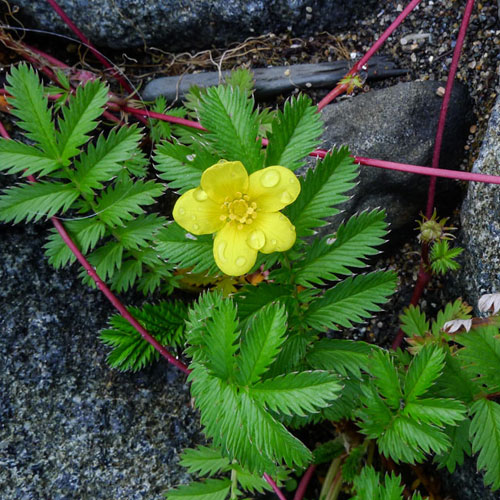 |
 |
| Pencilled Cranesbill |
Common Ragwort |
 |
 |
Slightly
disappointed by the dearth of birds at the Harbour, I thought it might
be better to relocated to the Titchfield Road car park. I planned to
walk past the Town Hall and along the South Beach to the golf course,
but sadly there was a para surfing event underway on the South Beach.
Also, the promenade and sea shore along to the Town Hall were stacked
with day trippers.
I
decided to go as far as the Town Hall and was delighted to come across
a small, people-free area of seaweed-enriched beach where a few birds
were able to feed relatively free of disturbance. I managed half-decent
shots of a Rock Pipit and a couple of Wagtails, one Pied and the other Grey, as they foraged just below the sea wall. I also spotted a few summer plumage Turnstones on rocks near the shore.
| Rock Pipit |
Pied Wagtail |
 |
 |
| Grey Wagtail |
Turnstone in Summer plumage |
 |
 |
Near
the Town Hall I caught sight of a sunlit Jackdaw on the shore near the
sea wall. A Rook was hanging around some prom benches tidying up
discarded rubbish. On my way back to the car I came across another corvid,
a juvenile Carrion Crow searching for food on a grassy patch. The
crowds were becoming unacceptably dense so I ended my search and
returned to the car. My final shot in Troon was, taken at the sea wall,
of an Oystercatcher feeding around the rock pools.
| Jackdaw |
Rook |
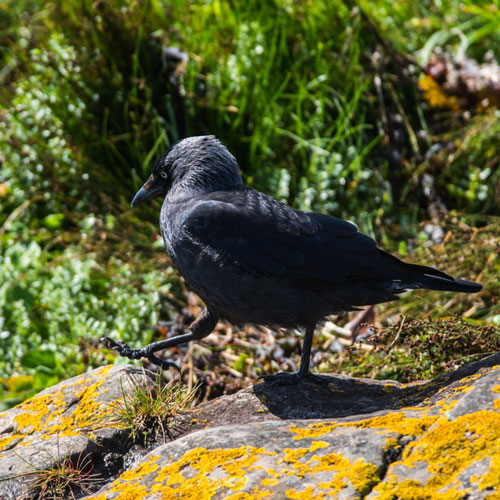 |
 |
| Juvenile Carrion Crow |
Oystercatcher |
 |

|
I
travelled the few miles north along the A75 to Irvine Harbour. The
weather was now very sunny but a little breezy. I stood for a while on
the promenade opposite the confluence of the Garnock and Irvine rivers.
Below is the view downstream towards the harbour mouth. Notice the
Bridge of Scottish Invention.
Straight away I captured a pleasing image of a Cormorant
as it dashed along the River Irvine. This was followed by a nice
portrait of a Herring Gull nestling on the grass surrounding the
parking area. A flock of Mute Swans were feeding in the Garnock just
before it reached the Irvine, and on a sandy shore opposite the swans a
few adult and juvenile Sandwich Terns has just flown in.
| Cormorant |
Herring Gull |
 |
 |
| Mute Swan |
Sandwich Tern |
 |
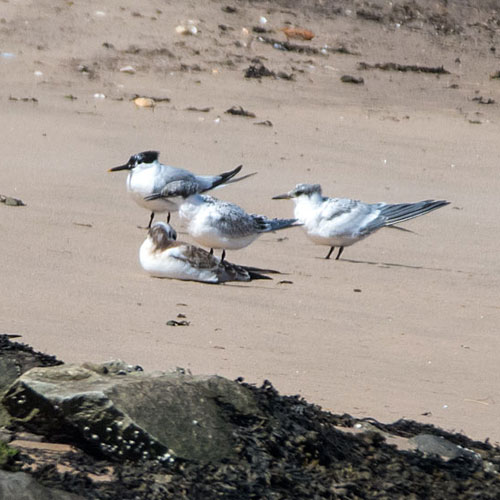 |
As
I photographed the Terns, a Great Black-backed Gull flew in and perched
on a post by the Swans. It held the same pose for the half hour I was
observing there and I’d conclude it was having a snooze. Then, as
I photographed a few female and juvenile Eiders paddling upstream from
the harbour mouth, a Jackdaw came into view below my feet, by the
river, on a bed of seaweed. It was very strongly lit by the sun and was
probably after invertebrates breeding in the weed. Soon afterwards a
juvenile Herring Gull landed at the other side of the prom railings,
flapped a few times and flew off again .
| Great Black - backed Gull |
Eider |
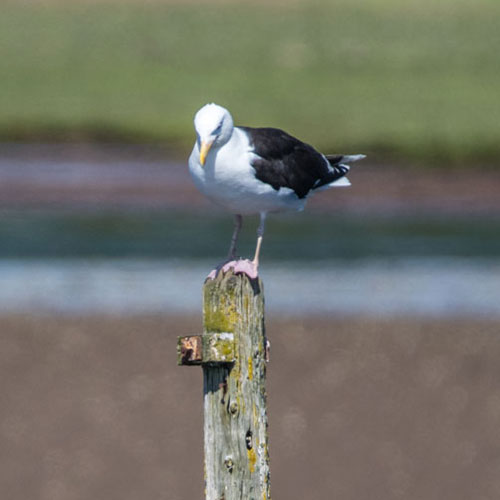 |
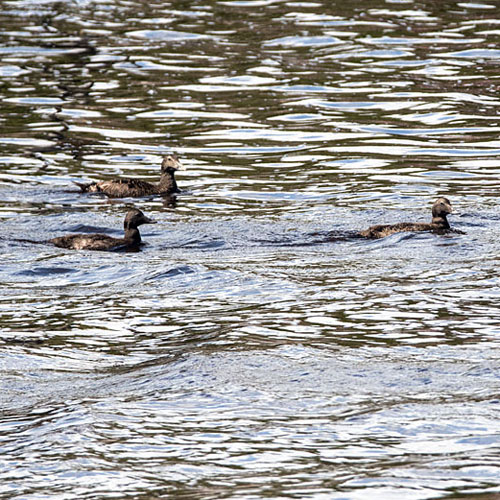 |
| Jackdaw |
1st Cycle Herring Gull |
 |
 |
The photo below shows some of the swans moving in line onto the Irvine from their feeding positions on the Garnock.
As
I walked past the Bridge of Scottish invention towards the harbour
mouth, I was pleased to catch a Black-headed Gull as it flew down
stream. Two birds perching on metal pillars midstream on the river. On
one was a preening Cormorant and on the other a Shag was having a nap.
My last shot of the day was of a charming Mute Swan dabbling at the
side of the river by the old Harbour Pilot building.
| Black - headed Gull |
Cormorant |
 |
 |
| Shag |
Mute Swan |
 |
 |
It
had been an enjoyable, if unremarkable, outing. I am pleased with the
haul of pictures. I did notice a few places were much quieter than in
the past, eg Troon Harbour. I wonder if the birds have disappeared due
to the lockdown keeping chip-eating and, chip-casting, humans from the
areas. The cars have now returned, but the birds have not.
19th July 2020: Musselburgh, Port Seton
On Sunday I made a long-awaited return to
an old favourite site of ours, Musselburgh. I would have visited last
week, but the tide would have been too low. This week it was just
right. When I arrived at the Levenhall Links
car park I was greeted by some Carrion Crows and my short walk to the
sea wall produced a sun-bathing Small Tortoiseshell butterfly. On the
shore were a few Goosanders and, about 50m offshore, a very large flock
of Eider were floating, moulting. I started my long track towards the
mouth of the River Esk. Soon I was pleased to see some nervous,
twittering Goldfinches on Creeping Thistle.
| Carrion Crow |
Small Tortoiseshell Butterfly |
 |
 |
| Female Goosander |
Goldfinch |
 |
 |
A couple of hundred metres from the sea wall, Gannets were diving, but a lot closer were Sandwich Terns
passing every few minutes. Their creeking calls forewarned of their
approach but I was a bit dismayed that they didn’t dive for fish.
Large numbers of Curlew and Oystercatchers were arriving at the
Scrapes, a sure sign that the tide was coming in.
| Gannet |
Sandwich Tern |
 |
 |
| Curlew |
Oystercatcher |
 |
 |
I
mis-timed my visit by an hour though, because when I arrived at the Esk
mouth the waters were almost fully covering the inshore areas. Normally
there would still be a few waders to photograph but there were families
visiting the seaside, clambering about where the birds would have been.
However I did get a couple of nice shots: a passing Cormorant and a
Red-tailed Bumblebee on Coltsfoot. On my way back along the sea wall I
noticed a family of Eider diving close in. There was an eclipse drake nearby but I’m not sure if he was with them.
| Cormorant |
Red - tailed Bumblebee |
 |
 |
| Juvenile Eider |
Drake Eider in Eclipse plumage |
 |
 |
At
the Scrapes the scene was unexpected. The grass across the reserve was
wild and uncut - a much better-looking nature reserve and made me
wonder why it had been cut pre-lockdown, as surely a meadow would be
ecologically more sound - and would discourage the wayward dog walkers
that often find their way onto the reserve.
A Carrion Crow was picking its way through the long grass in front of the hide. On the shallow water an eclipse female Shelduck was dabbling. A small number of summer plumage Black-tailed Godwits flew in and settled on the west-most scrape, followed by a Dunlin flock.
| Carrion crow |
Shelduck in Eclipse plumage |
 |
 |
| Black - tailed Godwit |
Dunlin |
 |
 |
On my way back to the car I came across an Earwig beside
a crack in the sea wall. Nearby I noticed a 7-spot Ladybird clinging to
a Creeping Thistle. As I rounded the east perimeter of the reserve
White Campion flowers caught my eye, as did a Speckled Wood butterfly that was resting on a leaf on path-side grass.
| Common Earwig |
7-Spot Ladybird |
 |
 |
| White Campion |
Speckled Wood Butterfly |
 |
 |
I
decided to move to Port Seton to watch the rising tide at the rocks of
Wrecked Craigs. Quite often there the rising waters encourage birds
closer to the shore. When I arrived this process was already starting.
On the far rocks Cormorants were resisting a lashing from the choppy
waters. Sandwich Terns started to arrive from the east to settle on
rocks not far from the Cormorants. The smaller birds such as Dunlin had
had enough though. I watched a fairly large flock relocating to quieter
rocks nearer the shore. As I watched the departing Dunlin, a Pied
Wagtail flew in below my radar to see what he could find on the rocks.
| Cormorant |
Departing Dunlin |
 |
 |
| Sandwich Tern |
Pied Wagtail |
 |

|
The various gulls were also very active: Black-headed, Common,
Lesser Black-backed and Herring Gulls roamed the scene without much
effort and seemed to be thriving in the changeable conditions.
| Black - headed Gull |
2nd Cycle Common Gull |
 |
 |
| Lesser Black - backed Gull |
Herring Gull |
 |
 |
But
most interesting were the Sandwich Terns with their juveniles. I
watched for an hour as they gradually and cautiously moved to rocks
closer to the promenade. I noticed a few incoming Terns had fish in
their beaks. However I didn’t see any of these passed to waiting
juveniles.
It
had been a successful return to our old haunts, albeit without my
trusty companion. However the way things seem to be going, surely it
shouldn’t be too long before the status quote is re-established.
12th July 2020: Barns Ness, Belhaven Bay
With good weather forecast for Sunday, I ventured out on my first
non-local Sunday outing. I decided on Barns Ness on the Lothian coast.
In the early hours of Sunday I took advantage of a cloudless sky by
taking a picture of Comet Neowise,
the first naked-eye comet for many years. So with that success in the
bag I was looking forward to an equally successful afternoon at Barns
Ness. I started at the old caravan park which is now overgrown with
some lovely wildflowers such as Vipers Bugloss and some flowers I
suspected were part of an old garden, English Stonecrop and
Lady’s Mantle.
| Comet Neowise |
White - tailed Bumblebee |
 |
 |
| English Stonecrop |
Lady's Mantle |
 |
 |
As
I made my way through the back of the old caravan park I got some nice
views of the lighthouse, now a holiday home. In the long grass there
were many Small Heath butterflies flitting nervously and also many 6-spot Burnet Moths feeding on Creeping Thistles. I also came across a Small Skipper butterfly feeding on Common Ragwort.
I
photographed Common Mallow and Red Poppies growing on the perimeter of
the farmed fields to the south of the Ness. I also snapped some shots
of a pair of Carrion Crows that were resting on the field wall, and
also a calling Yellowhammer .
| Common Mallow |
Red poppy |
 |
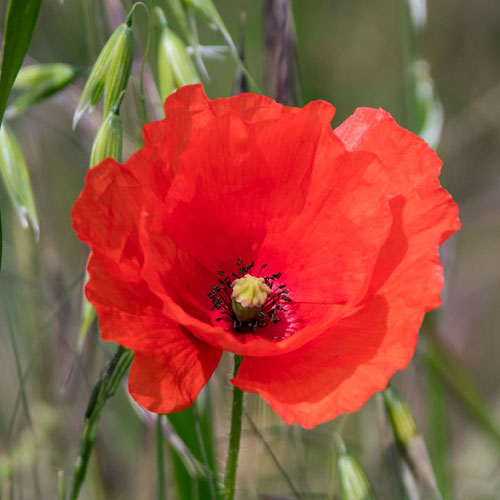 |
| Carrion Crow |
Yellowhammer |
 |

|
As
I crossed the sheep’s field on my way to the seashore, I noticed
many Meadow Brown and Ringlet butterflies. The two species don’t
quite seem to get on, as I saw several pairs engaged in frantic
“dog-fights”. The many Ragwort plants in the field were
occupied by orange and blackstriped Cinnabar Moth caterpillars. I also photographed a Red-tailed Bumblebee on one Ragwort plant.
| Meadow Brown Butterfly |
Ringlet Butterfly |
 |
 |
| Cinnabar Moth Caterpillar |
Red - tailed Bumblebee |
 |
 |
The seashore was a major disappointment. The tide was low, so the
water, and birds were a few hundred rocky metres away. I took
consolation in photographing more wildflowers. Lovely violet Harebells
nodding in the breeze, and a flower of the hybrid of Red and White
Campion. At the lighthouse, a worse-for-wear Painted Lady fluttered
onto a rock looking like it had just arrived from the Sahara. I did
though find a bird on the sea shore, a Rock Pipit. It was foraging for
insects. I wondered if it had a taste for Painted Ladys.
| Harebell |
Red and White Campion Hybrid |
 |
 |
| Painted Lady Butterfly |
Rock Pipit |
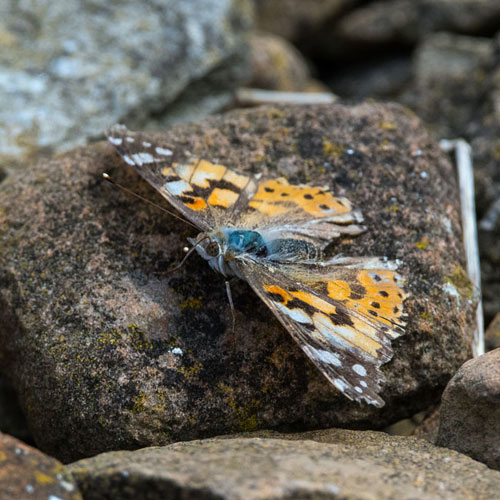 |
 |
To
add to my haul of pictures I decided to drive through Dunbar to
Belhaven Bay. From the single track road, on my way out of Barns Ness I
was delighted to see some Barn Swallows
resting on the wire fence. At Belhaven it was nice to see a couple of
sea birds, Black-headed and Herring Gulls. Yes, I know they’re
very common, but I hadn’t seen many during the lockdown, and I
felt it was a bit of a minor reunion. I heard a Reed Bunting calling
from within a bank of reeds at the edge of Seafield Pond.
Eventually, with a combination of careful manoeuvring and a helpful
breeze, I managed to capture an image of the bird.
| Barn Swallow |
Black - headed Gull |
 |
 |
| Herring Gull |
Reed Bunting |
 |
 |
On
the south edge of the pond, a Moorhen chick caught my attention as it
paddled alone across the water to its parent on raised ground. As I
made my way back to the car I was pleased to see a Goldfinch on the sea wall. Another long lost friend.
I
had a pleasing cup of tea and a Bounty at the car. It had been a brief
but pleasing trip with several high points such as the many butterflies
and burnet moths, the calling Yellowhammer and of course seeing my
much-maligned friends, the gulls.
Week ending: 5th July 2020: Hogganfield Loch LNR , Strathclyde Park
Due
to inclement weather It was Thursday before I managed a nature-watching
outing, with a circuit of Hogganfield Park LNR. There had been reports
of a Red-necked Grebe
there, but try as I might, I couldn’t see it. I did though get
nice shots of its cousin, the Little Grebe, diving on the east side of
the loch. It got scared off by a rather aggressive Coot charging from
the reeds. In a puddle under a tree I saw a very wet Bullfinch taking a
bath and near there I came across a Willow Warbler catching flies along
a long line of bushes.
| Little Grebe |
Coot |
 |
 |
| Bullfinch |
Willow Warbler |
 |
 |
The artificial islands to the east of the
island are now bare of their vegetation due to perching and nesting
birds. A pair of Coots with three chicks were almost ready to leave
their nest, while “next door” a pair of Great Crested
Grebes were taking turns sitting on their eggs.
The artificial islands on
the west side of the island have fared better. They have strong netting
protecting the plants and also have an area on each island for birds to
perch on. There are usually many birds around the artificial islands, a
source of photo-opportunities. On Thursday I got decent shots of a Mute
Swan, a Black-headed Gull in flight and a juvenile Moorhen trying to
dodge the swans. I snapped a Magpie foraging on the bank before it made
off into a tree.
| Mute Swan |
Black - headed Gull |
 |
 |
| Juvenile Coot |
Magpie |
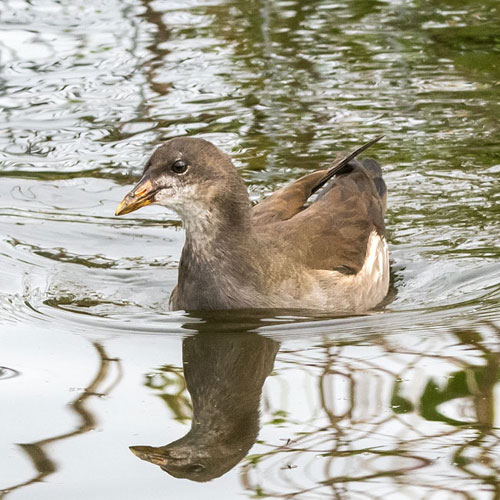 |
 |
I
was pleased to see a mating pair of Common Blue Damselflies on lochside
reeds. I was following the progress of a pair of Great Crested Grebes
as they trailed their single and pleading chick behind them. I was
after a shot of an adult feeding a fish to the chick, but it
didn’t happen. Perhaps they couldn’t find a fish big enough
to satisfy the big chick.
| Common Blue Damselfly |
Juvenile Great Crested Grebe |
 |
 |
Below is a view of the raft moored off the
north west side of the loch. It was occupied mainly by Lesser
Black-backed Gulls and a few Greylag Geese.
Just as I was making my way to the car I came across a large Brown Rat lurking in the lochside reeds near some Canada Geese that had been attracted out of the water by people with bread.
| Brown Rat |
Canada Goose |
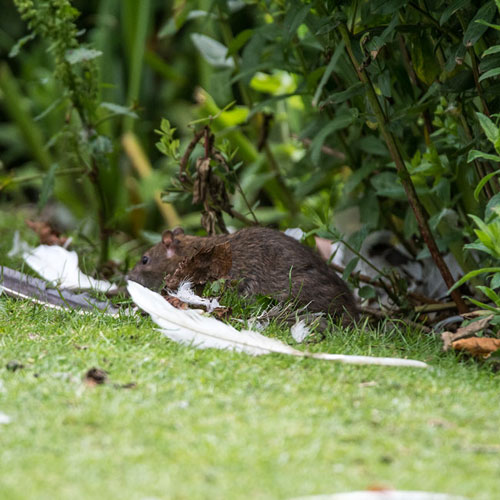 |
 |
I returned home for a spot of lunch and afterwards set off on my second
visit of the day, to Strathclyde Country Park where I walked around the
Loch. On my circuit I photographed the various species of Geese I
passed. The most predominant of these were Greylag Geese , of which there must have be several hundred. Amongst them noticed a Pink-footed Goose that should have been back in Iceland with the rest of its flock. However, even further from its flock was a beautiful Bar-headed Goose. It was most likely to have been an escapee from a private collection since it is native to Central Asia.
| Pink - footed Goose |
Greylag Goose |
 |
 |
As I rounded the north end of the Loch I noted that the Spear Thistles were
in bloom. I also spotted a Song Thrush gobbling berries in the tall
bushes. There was a very pale brown Greylag that may have been a
leucistic Greylag. Next to the Foreshore car park I noticed a white
goose that I have previously identified as a domestic Embden Goose.
However, on closer inspection of its plumage, I can see faint ochre
markings on its sides that indicate that it may be a white morph Greylag, a hybrid of a wild and domestic goose. I’ll do some further research and report back if I have any luck.
| Spear Thistle |
Song Thrush |
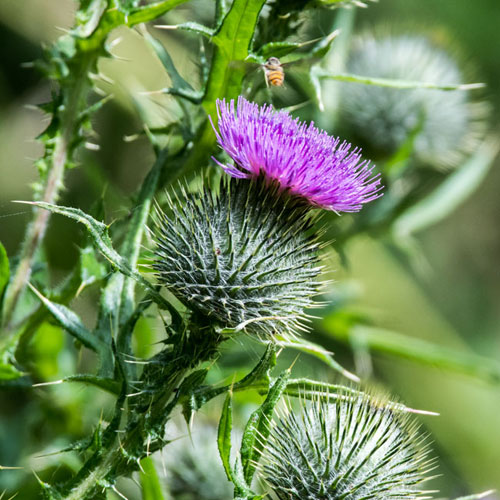 |
 |
| Leucistic Greylag Goose |
Greylag White Morph. T.B.C. |
 |
 |
Other
notable sightings on my circuit of the loch were, a nice flight shot of
a female Mallard, a tiny Toad in great danger of getting trampled on
the very busy footpath, a beauty Buddleja flower (but sadly no
butterflies) and a diving Cormorant.
| Female Mallard |
Common Toad |
 |
 |
| Buddleja |
Cormorant |
 |
 |
Disappointed
to have missed the Red-necked Grebe I revisited Hogganfield on Friday.
The weather was dreich though, but I did see the bird, distant, and in
rather dim lighting, off the north side of the island. I also got a
couple of nice shots of a Grey Heron and I watched a couple of Coots
feeding their single young chick. I also managed a visit to Port Seton
on the Lothian coast where I got a picture of a Rose-coloured Starling .
| Red - necked Grebe |
Grey Heron |
 |
 |
| Coot Hatchling |
Rosy Starling |
 |
 |
So despite the dodgy weather I managed to get
a pleasing set of pictures, three of which are of new sightings for us,
the Red-necked Grebe, the Bar-headed Goose and the Rose-coloured
Starling. A good omen for the next period of relaxation of lockdown
when we can travel further than 5 miles.
Highlights - July 2020
Below
are some of my favourite pictures taken during July 2020 listed in
loose themes. There’s no commentary. We hope you enjoy the photos.
BABY PICTURES
| Black - headed Gull |
Coot |
 |
 |
| Mallard |
Great Crested Grebe |
 |
 |
FLOWERS
| Betony |
Meadow Cranesbill |
 |
 |
| Field Scabious |
Red Clover |
 |
 |
| Spear Thistle |
Perforate St John's Wort |
 |
 |
PORTRAIT
| Coot |
Female Mallard |
 |
 |
| Mute Swan |
Pink - footed Goose |
 |
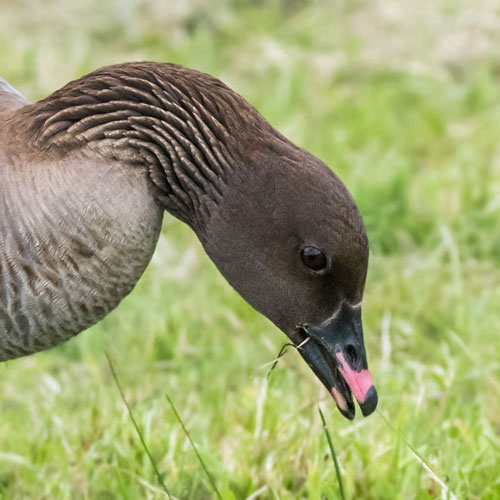 |
INVERTEBRATES
| 6 Spot Burnet Moth |
Blue - tailed Damselfly |
 |
 |
| Common Blue Damselfly |
Common Soldier Beetle |
 |
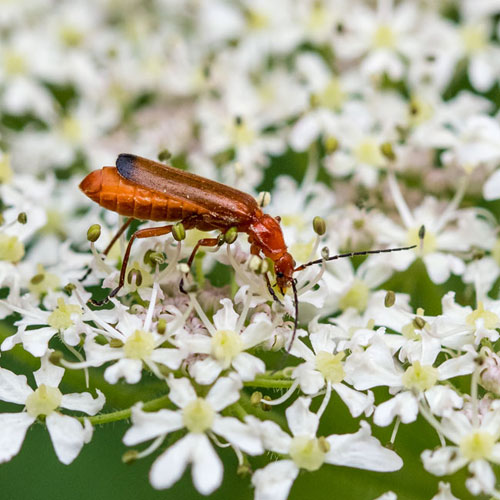 |
| Emerald Damselfly |
Green Leafhopper |
 |
 |
| Red - legged Shieldbug |
Sunfly |
 |
 |
BUTTERFLIES
| Green - veined White |
Meadow Brown |
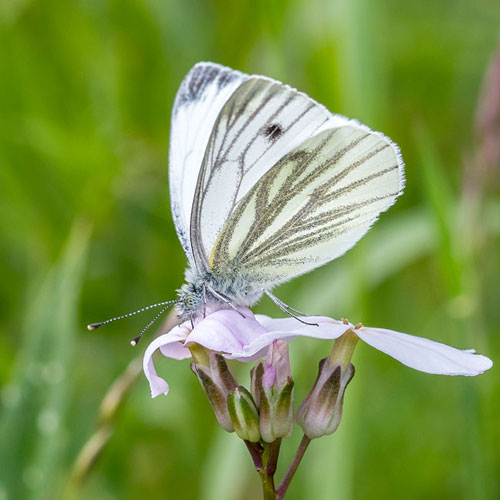 |
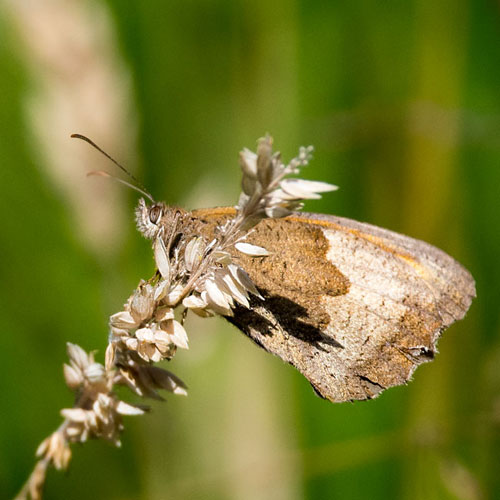 |
| Red Admiral |
Ringlet |
 |
 |
IN THE AIR
| Black - headed Gull |
Coot |
 |
 |
| Gannet |
Mallard |
 |
 |
GEESE
| Bar - headed Goose |
Leucistic Greylag Goose |
 |
 |
| White Morph Greylag Goose |
Pink - footed Goose |
 |
 |
IN THE WATER
| Black - tailed Godwit |
Cormorant |
 |
 |
| Dunlin |
Great Crested Grebe |
 |
 |
| Greylag Goose |
Red - necked Grebe |
 |
 |
Back To Top |

